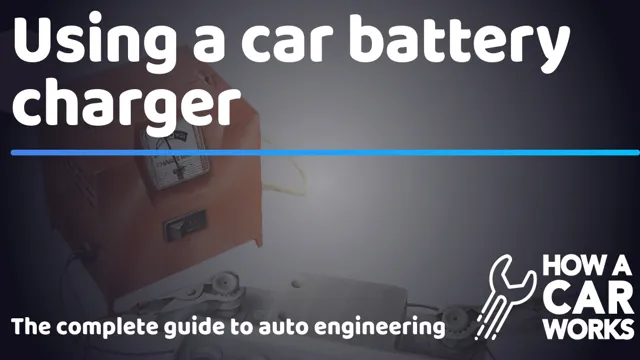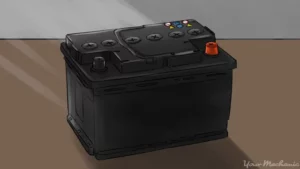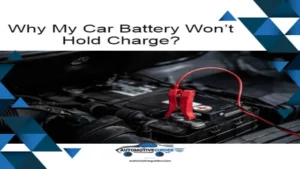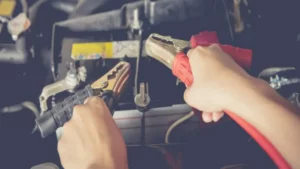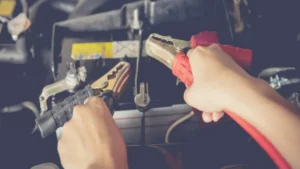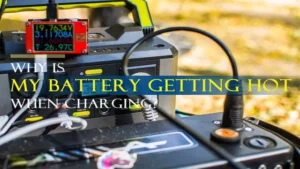The dreaded moment has come – your car battery has died, and you need to get it charged ASAP. But what do you do? Fear not! In this beginner’s guide, we’ll walk you through the process of using a car battery charger from start to finish. Whether you’ve never touched a charger before or just need a refresher, we’ve got you covered.
By the end of this guide, you’ll be able to confidently charge your car battery and get back on the road in no time. Let’s get started!
Step 1: Prepare Your Charger and Battery
If you’re wondering how to use a car battery charger, the first step is to prepare your charger and battery. Find a safe and level area to work in and make sure that you have all the necessary tools and equipment. Begin by connecting the cables to the charger.
The red cable should be attached to the positive (+) terminal on the battery and the black cable to the negative (-) terminal. Ensure that the charger is unplugged during this process to avoid risk of electric shock. Before plugging in the charger, double-check that the connections are secure and that the charger settings match the specifications for your specific battery.
Once everything is in place, you can plug the charger into a power outlet and start the charging process. Following these steps will ensure that you are safely and properly using your car battery charger.
Get the Right Charger
When it comes to charging your electronic devices, it’s important to get the right charger for the job. A mismatched charger can cause damage to both your battery and device, so it’s essential to be prepared with a compatible charger. First, check the specifications of your battery and device to determine what type of charger you need.
Some devices require a high-powered charger, while others may only work with a specific type of connector. Once you have identified the correct charger, ensure that it is in good condition and free from damage. A damaged charger can pose a safety risk, so it’s important to inspect it regularly.
By taking the time to prepare your charger and battery, you can ensure a safe and efficient charging experience every time. So the next time you need to charge your device, take the first step and get the right charger for the job.
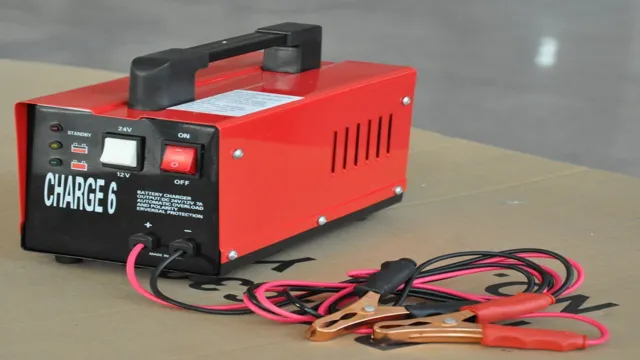
Check the Battery Condition and Voltage
Before checking your battery’s condition and voltage, it’s important to prepare your charger and battery. To do this, ensure that your charger is compatible with your battery and has the right charging settings. Double-check if it’s safe to charge your battery indoors or if it should only be charged in a well-ventilated area.
Next, make sure that your battery is in good condition and free from damage. Check the battery’s terminals and make sure they’re clean and free of corrosion. Additionally, check the battery’s voltage using a multimeter.
If the voltage is below the recommended level, charge the battery immediately. Preparing your charger and battery for testing ensures the accuracy of your battery’s condition and voltage readings, allowing you to properly diagnose and address any issues.
Step 2: Choose the Charging Mode
When it comes to using a car battery charger, choosing the right charging mode is key. There are typically three modes available: trickle charge mode, fast charge mode, and jump start mode. Trickle charge mode is best for maintaining a battery’s charge over a long period of time, and it’s great for batteries that are already fully charged.
Fast charge mode, on the other hand, should only be used on batteries that are completely dead as it can lead to overheating and even damage to the battery if used too often. Jump start mode is specifically designed for jump starting a dead battery, and it provides a quick burst of energy to get the battery going. Remember to always read the instructions on your particular charger and select the appropriate mode for your battery’s condition.
By choosing the right charging mode, you can ensure that your battery stays healthy and charged for years to come.
Manual vs Automatic
When it comes to charging your electric car, one of the first decisions you need to make is whether to use manual or automatic charging mode. The manual mode means that you will have to physically press a button to start and stop the charging process, while the automatic mode will do it all for you. So which one is better? It really depends on your personal preferences and needs.
For example, if you prefer to have more control over the charging process and want to monitor it closely, then manual mode might be the way to go. On the other hand, if you want the convenience of not having to remember to start and stop charging, automatic mode might be more suitable for you. Ultimately, both modes are reliable and effective, so it’s just a matter of figuring out which one works best for you and your lifestyle.
Select the Charging Rate
When it comes to electric vehicles, it’s important to choose the right charging mode. In other words, you need to select the charging rate that will work best for your needs. This decision will depend on a few different factors, including how far you need to travel and how long you have to charge.
One option is to use a high-power charging station. These are typically found along major highways and can charge your vehicle in as little as 30 minutes. However, if you don’t need to travel long distances, you may be able to get by with a slower charging rate.
This can be a more cost-effective option and can help protect your vehicle’s battery in the long run. Ultimately, the key is to choose a charging mode that will work best for your specific needs and usage patterns. So take some time to consider your options and make an informed decision.
Step 3: Connect the Charger to the Battery
So, you’ve got your car battery charger and you’re ready to charge your dead battery. The next step is to connect the charger to the battery itself. Before doing so, make sure your charger is unplugged from the electrical outlet and turned off.
Then, locate your battery under the hood of your car. Identify the positive and negative terminals, which are usually marked with a plus (+) and minus (-) sign respectively. Connect the red or positive charger clamp to the positive terminal first, and then the black or negative clamp to the negative terminal.
Make sure the clamps are securely attached to the battery terminals, and avoid touching both clamps together or touching them to other metal parts. Once you’ve connected the charger, plug it in and turn it on. Now, you’re all set to charge your battery! Just remember to keep an eye on it and remove the clamps in the reverse order once the battery is fully charged.
That’s all there is to it when it comes to using a car battery charger.
Connect the Positive and Negative Clamps
When you’re ready to charge your battery, the next step is connecting the positive and negative clamps. This is a crucial step if you want to power up your car battery efficiently and safely. It’s essential to ensure everything is connected correctly to avoid any accidents or damage to your vehicle.
Start by locating the positive (+) and negative (-) terminals on the battery. Grab your charger and identify the red and black clamps, matching the positive clamp to the positive terminal and the negative clamp to the negative terminal. You should hear a clicking sound as you connect the clamps to the battery, indicating a secure connection.
Double-check that the charger is set to the correct voltage and amps before you power it up. Once everything is in place, go ahead and turn on the charger, and you should see the ammeter begin to move higher and higher, indicating that the battery is charging. Remember to keep a close eye on the charger and battery throughout the charging process, and don’t leave the charger connected for too long, or it could overcharge your battery, causing more problems down the road.
By following these steps, you should be able to charge up your car’s battery within a few hours, ready to hit the road again.
Make Sure the Connection is Secure
When it’s time to connect your charger to your battery, it’s essential to make sure that the connection is secure. You don’t want any wiggling or loose connections that could lead to damage or even a potential safety hazard. Start by ensuring that your charger is compatible with your battery.
Check the voltage and amperage ratings to ensure that they match. Next, clean the battery posts to remove any corrosion or buildup that could interfere with the connection. Then, attach the charger clips to the battery posts, making sure that the red clip is connected to the positive post, and the black clip is connected to the negative post.
Once everything is securely connected, turn on the charger and make sure that the charging process has begun. Remember, safety first, so always double-check your connections and make sure that the charger is working correctly before leaving it unattended.
Step 4: Start Charging
Now that you have your car battery charger set up and connected to your dead battery, it’s time to start charging! Before you begin, make sure to double-check the charger’s specifications and adjust the charging rates accordingly. Charging a car battery typically takes several hours, so it’s important to be patient and never rush the process, as it could cause damage to the battery or even the charger itself. As the battery charges, keep an eye out for the charger’s indicator lights, which will signal when your battery is fully charged, and you can disconnect the charger.
So, go ahead and plug in your charger, relax, and wait for your battery to come back to life!
Set the Timer (if Manual Mode)
If you’re using manual mode to charge your electric vehicle, the next step is to start the charging process. Before you do so, make sure your vehicle is properly connected to the charging station. Then, if your charger is equipped with a timer, set it to the amount of time you want to charge.
This is especially helpful if you only want to charge your vehicle for a specific amount of time, such as during off-peak hours when electricity may be cheaper. Once you’ve set the timer, or if your charger doesn’t have one, simply press the start button to begin charging. Your vehicle’s battery will begin to receive the necessary electricity, and you’ll be on your way to a full charge in no time.
So go ahead and start that charging process, and soon you’ll be ready for your next adventure on the road!
Watch the Battery Level
When using your electronic devices, it is crucial to keep an eye on the battery level. If left unattended, running out of battery can cause great inconvenience. To avoid this, regularly check the battery level and start charging your device whenever it is low.
This is especially important if you plan on using your device for an extended period without access to a charging port. Starting the charging process early can also prolong the life of your device’s battery. So, always be mindful of your battery level and keep your charger handy.
Think of your battery as the fuel tank of your car – just as you wouldn’t want to run out of gas in the middle of a road trip, you don’t want to be left stranded without a charged device. Keep the keyword “battery level” in mind, and you’ll be on your way to uninterrupted device usage.
Step 5: Disconnect the Charger
After your vehicle’s battery has been charged, it’s crucial to disconnect the charger properly. First, make sure that the charger is off and unplugged from the electrical outlet. Then, remove the clamp from the negative terminal of the battery first, followed by the clamp from the positive terminal.
This sequence is crucial as it helps prevent sparks from occurring and reduces the risk of electrical damage to your vehicle. Once both clamps have been removed, safely store the charger until it’s needed again. Remember to handle the charger with care and keep it away from extreme heat or moisture.
By following these simple steps, you can safely and effectively use a car battery charger to recharge your battery and extend its longevity.
Switch off the Charger and Remove Clamps
Now that your car battery is fully charged, it’s time to disconnect the charger and remove the clamps. This is an important step in the process to ensure the safety of both you and your vehicle. First, switch off the charger and unplug it from the power source.
Then, remove the black clamp from the negative battery terminal and the red clamp from the positive terminal. Be sure to do this in the reverse order of how you connected them earlier. This will prevent any accidental sparks or electrical shocks from occurring.
Keep in mind that leaving the charger connected to your car battery for too long could cause damage to both the battery and the charger. So, it’s essential to disconnect the charger as soon as the battery is fully charged. By following these steps, you can safely and efficiently charge your car battery and keep your vehicle running smoothly.
Clean and Store the Charger Properly
When it comes to prolonging the lifespan of your charger, it is essential to know how to disconnect it properly. Once you’re done charging your device, unplug the charger from both the power outlet and the device. Don’t yank the cable out as it can cause damage to the cord or the port.
Instead, hold the plug firmly, and gently pull it out. Avoid fiddling with the cord, as this can cause it to fray or break. After unplugging the charger, make sure to store it correctly.
Keeping it in a safe and dry spot, away from potential hazards like water, dust, and extreme temperatures, is crucial. Wrapping the cord neatly around the charger and securing it with a velcro strap or twist tie can also help avoid tangles and cable damage. By following these simple steps, you can ensure a longer life for your charger and keep your devices running smoothly.
Conclusion
Well folks, using a car battery charger is as easy as charging your phone. Just connect the cables, plug it in, and let it do its thing. It’s like the superhero of charging, bringing life back to your dead battery.
So, the next time your car battery needs a boost, don’t be left stranded – grab a charger, save the day, and be the hero your car needs!”
FAQs
What is a car battery charger and how does it work?
A car battery charger is a device used to recharge a car battery. It works by supplying an electrical current to the battery, which charges it up and restores its power.
Can I use a car battery charger on other types of batteries?
It depends on the charger. Some car battery chargers are designed specifically for use with cars, while others can be used on other types of batteries as well. Check the manufacturer’s instructions before attempting to use a car battery charger on a different type of battery.
How long does it take to charge a car battery with a charger?
The time it takes to charge a car battery with a charger depends on the charger’s output and the size of the battery. Typically, it can take anywhere from a few hours to overnight to fully charge a car battery.
What safety precautions should I take when using a car battery charger?
Always wear protective gear such as gloves and safety glasses when working with a car battery charger. Make sure the charger is unplugged before making any adjustments or connections. Follow the manufacturer’s instructions carefully to avoid electrical shock or other hazards.
Can a car battery be overcharged with a charger?
Yes, it is possible to overcharge a car battery with a charger. This can lead to damage to the battery or even cause it to explode. Be sure to monitor the charging progress closely and disconnect the charger once the battery is fully charged.
What should I do if my car battery won’t hold a charge even after using a charger?
If your car battery won’t hold a charge even after using a charger, it may be time to replace the battery. Other potential causes could include a faulty alternator or other electrical issues.
Are there different types of car battery chargers available?
Yes, there are several different types of car battery chargers available, including trickle chargers, float chargers, and smart chargers. Each type has its own unique features and benefits, so it’s important to choose the right type of charger for your needs.
